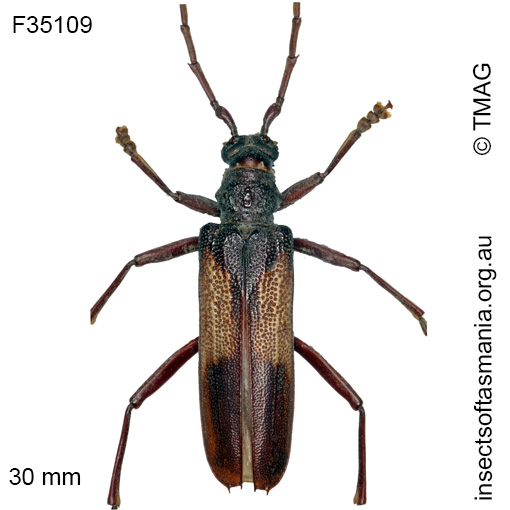
Phoracantha mastersi
Basis for Tasmanian occurrence
TMAG collections
Classification
Suborder: Polyphaga
Superfamily: Chrysomeloidea
Family: Cerambycidae
Subfamily: Cerambycinae
Tribe: Phoracanthini
Morphology
Flightedness: winged and assumed capable of flight
Source literature on morphology and taxonomy (*primary taxonomic source, where identified):
Wang, Q. (1995a). A revision of the Australian genus Phoracantha Newman (Coleoptera: Cerambycidae). Invert. Taxon. 9: 865-958.
Ślipiński, A. & Escalona, H. (2016). Australian longhorn beetles (Coleoptea: Cerambycidae), Volume 2: Subfamily Cerambycinae. CSIRO publishing, 640 pp.
Ecology
Association with dead wood or old trees: obligately saproxylic
Ecological attributes: — Eucalyptus globulus is a host-plant (Bashford, 1990a) — Eucalyptus obliqua is a host-plant (Bashford, 1990a) — Eucalyptus viminalis is a host-plant (Bashford, 1990a) — Can cause mortality in young Eucalyptus nitens and E. globulus (Bashford, 1995).
Collection method(s) for TMAG material: — Hand collection (substrate not specified) — Not specified — Rearing in insectary from Eucalyptus globulus — Rearing in insectary from Eucalyptus nitens — Rearing in insectary from Eucalyptus obliqua — Rearing in insectary from Eucalyptus viminalis — Sticky trapping on Eucalyptus globulus — Vane trapping.
Source ecological literature:
Bashford, R. (1990a). Tasmanian forest insects and their host plants: records from the Tasmanian Forestry Commission insect collection. Hobart: Tas. Forestry Commission, 32 pages.
Bashford, R. (1995). Tryphocaria mastersi Pascoe: a cerambycid causing death of young E. nitens and E. globulus in Tasmania. Forest Entomology Research Working Group Newsletter 12: 29-31.

